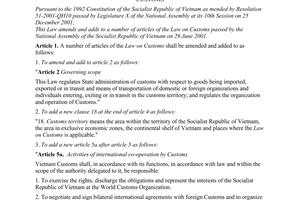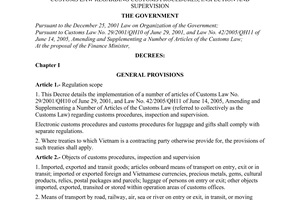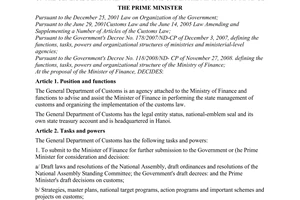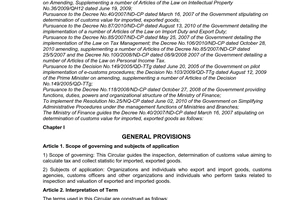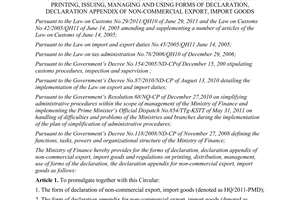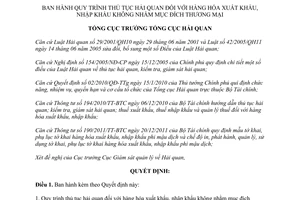Nội dung toàn văn Decision No. 3125/QD-TCHQ promulgating the process of customs procedures for exp
|
THE MINISTRY OF FINANCE |
SOCIALIST REPUBLIC OF VIET NAM |
|
No. 3125/QD-TCHQ |
Hanoi, December 28, 2012 |
DECISION
PROMULGATING THE PROCESS OF CUSTOMS PROCEDURES FOR EXPORT AND IMPORT GOODS FOR NON-COMMERCIAL PURPOSE
THE GENERAL DIRECTOR OF THE GENERAL DEPARTMENT OF CUSTOMS
Pursuant to the Law on Customs No. 29/2001/QH10, of June 29, 2001 and Law No. 42/2005/QH11, of June 14, 2005 amending and supplementing a number of articles of the Law on Customs;
Pursuant to the Government’s Decree No. 154/2005/ND-CP of December 15, 2005 detailing a number of articles of the Law on Customs on customs procedures, inspection and supervision;
Pursuant to the Decision No. 02/2010/QD-TTg of January 15, 2010, of the Prime Minister defining functions, tasks, powers and organizational structure of the General Department of Customs, under the Ministry of Finance;
Pursuant to the Circular No. 194/2010/TT-BTC of December 06, 2010 of the Ministry of Finance guiding customs procedures, inspection and supervision; import and export tax, tax management for exports, imports;
Pursuant to the Circular No. 190/2011/TT-BTC of December 20, 2011, of the Ministry of Finance, providing for forms of the declaration, the declaration appendix for non-commercial export, import goods and regimes of printing, issuance, management and use of declaration, declaration appendix of non-commercial export, import goods;
At the proposal of the Director of Customs control and supervision Department,
DECIDES:
Article 1. To promulgate together this Decision:
1. The process of customs procedures for export and import goods for non-commercial purpose;
2. The professional request: Form 01/PYCNV/2012;
3. The customs dossier receipt and handing: Form 02/PTN-BGHS/2012
Article 2. This Decision takes effect on January 15, 2013. During implementation, if the relevant documents mentioned in this Decision are amended, supplemented or replaced, such new documents shall be implemented.
Article 3. Directors of provincial Customs Departments, heads of units under the General Department of Customs shall implement this Decision.
|
|
FOR THE GENERAL DIRECTOR OF THE GENERAL DEPARTMENT OF CUSTOMS DEPUTY GENERAL DIRECTOR |
THE PROCESS
OF CUSTOMS PROCEDURES FOR EXPORT AND IMPORT
GOODS FOR NON-COMMERCIAL PURPOSE
(Promulgated together with the Decision No. 3125/QD-TCHQ, of December
28, 2012)
SECTION I. GENERAL PROVISIONS
Article 1. Scope of application
1. This process guides customs procedures for export and import goods for non-commercial purpose (hereinafter referred to as non-commercial export and import commodities).
2. This process shall not apply to export, import goods sent through mail express services by international airway or by road; postal matters, export/import commodities sent through postal services; luggage of people on entry or exit which must declare customs and do customs procedures; machines, equipment, professional instruments temporarily-imported, temporarily-exported with specified time limit being brought along to people on entry or exit.
Article 2. Subjects of application
Customs cadres, civil servants.
Article 3. Locations for customs procedures performance
1. Customs procedures for non-commercial import goods are performed at Customs Sub-Departments of border-gates or Customs Sub-Departments where non-commercial import goods are moved arrival port as prescribed.
2. Customs procedures for non-commercial export goods are performed Customs Sub-Departments which have been established as prescribed.
Article 4. Principles in performance of customs procedures for Customs Sub-Departments non-commercial export/import goods
1. The non-commercial export/import goods are managed in according to current regulations on export/import goods management policy, tax policy, customs dossiers of each type of export/import goods.
2. The non-commercial export/import goods include:
a. Overseas organizations' and individuals' donations and gifts to Vietnamese organizations and individuals; or those consigned by Vietnam-based organizations and individuals to overseas organizations and individuals;
b. Goods of Vietnam-based diplomatic representative missions and international organizations and their staff;
c. Goods as humanitarian aid;
d. Temporarily imported and exported goods of individuals entitled to tax exemption by the Vietnamese State;
dd. Free sample goods;
e. Temporarily imported and exported working tools and means of agencies, organizations or people on entry or exit for a specified period.
f. Movable assets of organizations or individuals
g. Personal luggage of people on entry consigned under bills of lading, and hand luggage of people on entry which is in excess of duty-free quota
h. Other non-commercial goods.
3. Customs procedures for non-commercial export, import goods are performed in accordance with part II, chapter III of the Circular No. 194/2010/TT-BTC and relevant guiding documents.
4. The declaration of non-commercial export, import goods (HQ/2011-PMD) is used in order to perform customs procedures for non-commercial export and import goods.
5. Time of customs procedures performance for non-commercial export, import goods comply with current provisions as prescribed in Article 19 of the Law on Customs.
6. Opening management and monitoring book of declaration of non-commercial export, import goods have been registered comply with clause 4, step 1, Article 4 of this provision.
Article 5. Customs supervision for non-commercial export/import goods
1. Method of supervision and organization of supervision for non-commercial export, import goods at place performing customs procedures comply with guides of the General Department of Customs on customs supervision at each area.
2. Based on guides of the General Department of Customs and actual situation, Directors of provincial Customs Departments shall guide measures of examination, supervision which are conformable and ensure to meet state management requirements on customs.
SECTION II. SPECIFIC PROVISIONS
Article 6. Customs procedures for non-commercial export/import goods
The customs officers performing customs procedures for non-commercial export/import goods conduct the following steps:
Step 1: Receiving, checking dossier in details; registering customs declaration
1. Receiving customs dossier from customs declarer; dossiers which must be submitted; presenting of each type of non-commercial export, import goods specified in clause 3, Article 4 of this process comply with provisions in article 71, Article 72 of the Circular No. 194/2010/TT-BTC.
2. Checking conditions for declaration registration: Checking objects of customs declaration as prescribed in Article 70 of the Circular No.194/2010/TT-BTC policy on export, import goods management, relevant tax policy, value for tax calculation as prescribed in clause 5 Article 20 of the Circular No. 205/2010/TT-BTC of December 15, 2010.
Based on dossiers and information getting at time of checking, the customs officers receiving dossier check declaration of elements on declaration form, check declared content of customs declarer, check and count fully quantity, types of documents attached in customs declaration; check synchronism among documents in customs dossier; check conformity between declared contents with current law regulations on export, import management policy, tax policy and other law regulations.
3. Handling results of checking conditions for declaration registration:
3.1. If dossier are not eligible for declaration registration, returning dossier and notifying clear reason through the professional request (Form 01/PYCNV/2012) for customs declarer
3.2. If dossier is eligible for declaration registration, receiving set of dossier through the customs dossier receipt and handing (Form ) and perform the following jobs:
4. Registering declaration:
4.1. Filling number, sign of type, code of Customs Sub-Department, date, etc on customs declaration as prescribed in the Circular No. 190/2010/TT-BTC of December 20, 2010 of the Ministry of Finance;
4.2. Having signature and customs officer’s stamp on blank box “the registering customs officer”.
4.3. Sending customs dossier (which has been checked in details) to leader of Sub-Department for decision under provided competence.
5. Leader of Sub-Department shall, based on customs dossier, other information getting at time of declaration registration, decide forms, measures, locations, time for actually checking goods set in customs declaration.
Separately non-commercial export, import goods of subjects enjoyed privileges and immunities, based on actual situation and other information, Leader of Sub-Department shall decide to perform in according to current regulations on privilege and immunity regimes.
6. Based on decisions of leader of Sub-department on forms, measures, locations, time for actually checking goods, customs officer shall transfer dossier for other customs officer who perform step 3 for consignment which is exempted from checking actual goods; or customs officer shall transfer dossier for other customs officer who perform step 2 for consignment which must be checked actual goods.
Step 2: Checking actual goods and confirming result of checking
1. Checking actual goods:
1.1. Form of checking:
Depend on each specific case leader of Sub-department shall decide form, measure to check actual goods by scanners, scale or manually checking.
a. Checking by scanners:
At Customs Sub-Departments have been equipped scanners, checking actual goods is performed by scanners and images checked in scanners are saved, saved out tape, disk in accordance with regulation on process of scanner use for checking export, import goods (if Customs Sub-Departments having scanners perform this function).
b. Checking by scale:
At Customs Sub-Departments which have been equipped scanners, checking actual goods is performed by scales and weight of consignment in scale is saved in accordance with regulation on process of scale use for checking export, import goods; printing out paper on result of checking weight and saved with customs dossier for storage as prescribed.
c. Manually checking:
If Customs Sub-Departments have not yet equipped scanners, scales or there is information of doubt or affirmation on violation or upon checking by scanners, scales and detecting signs of violation, leaders of Sub-Departments shall decide manually checking. Depend on specific cases, leaders of Sub-Departments shall decide quantity of officers who check actual goods.
1.2. Content of checking actual goods:
Based on Article 14, Circular No. 194/2010/TT-BTC in order to implement for suitability with consignments of non-commercial exports or imports, content of checking must comply with principles: Checking and comparing actual exports or imports with content declared on the customs declaration and documents of set of customs dossier relating to: Name of goods, code of goods, calculation unit, quantity/weight of goods, quality of goods (if goods are in the list of goods subject to checking on quality).
1.3. Method of manually checking:
a. Checking situation of packaging;
b. Checking labels, signs, codes, basic characteristics of goods for defining name of goods, code of goods;
c. Checking quantity/weight of goods (weight, measure, count, appraise, etc, depend on each specific case);
d. Checking quality in according to guides in point 1, clause 2, Article 14, Circular No. 194/2010/TT-BTC (for cases required for checking quality).
2. Confirming result of checking actual goods
2.1. Goods are checked by scanners, scales or by agencies of specialized inspection or appraisal of traders:
a. Checking by scanners, confirming: “checking by scanner at location ………, concluding …….”, saving image of inspection in scanner, saving image out tape, disk as prescribed for process of using scanners;
b. Checking by scales, confirming: “checking by scale at location ………, concluding …….”, saving result of checking weight of consignment in scale as prescribed for process of using scales;
c. Checking by agencies of specialized inspection, confirming: “based on conclusion on checking of ……. At notice on result of checking No...., date....concluding....".
2.2. Goods are checked by manual method or combined with scanner, scale, clearly and particularly confirming part of goods checked by manual method and part of goods checked by scanner, scale.
2.3. Goods are manually checked 100% (checking entire goods):
a. If result of inspection is proper as declaration of customs declarers, confirming: “exports or imports are proper as declaration of customs declarers”;
b. If result of checking show that there are goods different from statement of customs declarer, it is required to particularly, fully and clearly confirm on content of redundancy or lack of those goods (including name of goods, code of goods, calculation unit, weight, etc); the remaining exports or imports which are proper with statement of customs declarer, it is required to particularly and clearly confirm “name, code, calculation unit, weight of exports or imports which are proper with statement of customs declarer”.
2.4. Officers check actual goods shall sign their names, seal their stamps at box “for officer checking actual goods” on the customs declaration (HQ/2011-PMD); concurrently, require customs declarers sign their name for confirming conclusion of inspection at box “for confirmation of senders/receivers/authorized persons” on the customs declaration (HQ/2011-PMD).
3. Handling result of inspection:
3.1. If result of inspection is proper with statement of customs declarers, to transfer dossier to step 3.
3.2. If result of actual goods inspection has difference in comparison with statement of customs declarers, to propose handling measures and submit them to leaders of Sub-Departments for consideration and decision under their competence as prescribed:
a. Making record on confirmation or record on violation, handling of violation under competence.
b. Reporting to consult superior agencies for cases beyond competence of Sub-Departments.
4. Transferring dossier to step 3.
5. For dossier which is allowed to submit documents later as prescribed or has not yet finished customs procedure such as waiting for result from agencies of line management, etc, leader of Sub-Department shall organize management, monitor and handle as prescribed.
6. For goods temporarily imported for re-export, temporarily exported for re-import without commercial purpose, after doing procedures for re-export, re-import, officers shall perform liquidation of declaration of temporary import, temporary export in accordance with current regulations.
Step 3: Calculation, collection of taxes and customs fees
1. Calculation and collection of taxes and customs fees are performed in accordance with regulation;
2. To seal confirmation stamp of “customs procedures have been finished” at box 24 of customs declaration.
3. To put in book of monitoring and return customs declaration (copy kept by customs declarer) to customs declarers.
4. To transfer dossier to officers performing step 4 (form 02/PTN-BGHS/2012)
Step 4: Dossier re-inspection
Officers of dossier re-inspection shall perform in according to process of dossier re-inspection for exports, imports promulgated by the General Department of Customs.
SECTION III. ORGANIZATION OF IMPLEMENTATION
Article 7. The responsibility of leaders of Departments
1. To take responsibility for organization, implementation of this process;
2. To solve problems in professional operation which arise and beyond competent of Sub-Departments in the course of doing customs procedures; to report for consulting superior agencies in cases of beyond the solving competence of Departments.
3. To handle violation for violation acts within handling competence of Directors of Departments.
Article 8. The responsibility of leaders of Sub-Departments
1. To assign, guide, inspect, urge officers who are assigned duty to implement in accordance with regulations of policy, law, process of customs procedures; to arrange officers and heads of teams who have professional qualification suitable with jobs assigned, under professional and advanced direction, not causing troubles; to take responsibility with superior agencies and before law for organizing to implement the process at their units.
2. To directly handle issues in competence of leaders of Sub-Department set in the process, specifying:
2.1. To approve or decide on change of forms, measures in inspection and approval of result of dossier inspection.
2.2. To decide late submission of some documents as prescribed in clause 2, Article 9 of the Decree No. 154/2005/ND-CP and to organize monitoring, handling in order to finish procedures for customs clearance.
2.3. To solve suggestions of goods owners for bringing goods back for preservation in case meeting requirements of customs supervision and to guide officers to confirm at box “other notes” on the customs declaration and sign name, seal customs officer's stamp.
2.4. To decide the assessment solicitation, analyzing, goods classification and tax imposition in accordance with regulation.
2.5. To solve problems in professional operation which arise and beyond competent of subordinate agencies in the course of doing customs procedures; to report for consulting superior agencies in cases of beyond the solving competence of Sub-Departments.
2.6. To handle violation for violation acts within handling competence of Directors of Departments; to finish procedures and transfer dossier of violation cases under the handling competence of superior agencies.
2.7. Other relevant jobs.
Article 9. The responsibility of customs officers
1. To abide assignment, direction, inspection, urging of leaders in charge of.
2. To take responsibility before superior agencies and law for implementation of jobs assigned in this process and other relevant regulations.
3. To properly and fully implement regulations of permitted to do and not permitted to do with respect to cadres, civil servants.
------------------------------------------------------------------------------------------------------
This translation is made by LawSoft and
for reference purposes only. Its copyright is owned by LawSoft
and protected under Clause 2, Article 14 of the Law on Intellectual Property.Your comments are always welcomed

